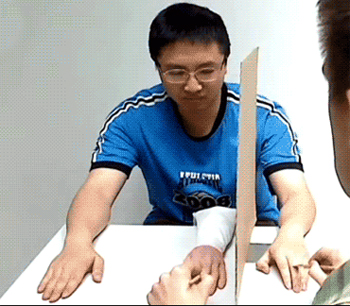Tuesday, 21 April 2020
The rubber-hand illusion

The sense that you have a body and can distinguish what’s part of it from what’s not is with you all the time. It’s so familiar that it’s hard to imagine not having it. Yet several experiments, such as the rubber-hand-illusion experiment described in this post, show that this sense is actually a complex construct that your brain assembles from the myriad pieces of sensory information that it receives constantly.
For example, if I ask you where your feet are right now, you’ll have a pretty good idea of their position. Even if you can’t see them because they’re hidden under your desk, for example, your brain can still determine their position fairly precisely, using the proprioceptive information that it receives from the position of your legs and the tension in their muscles, and the tactile information that it receives from the floor or any other object exerting pressure on your feet. In this way, your brain gives you the clear impression that your feet are really yours.
But in 1998, Matthew Botvinick and Jonathan Cohen published an article in the journal Nature about an experiment that they had conducted that showed that it’s actually pretty easy to fool your brain about what things are or are not part of your body. In this experiment, the researchers used the sense of sight–which is especially important for human beings—to fool their subjects into thinking that a fake, rubber hand might actually be their own.
To understand how this illusion works, you have to put yourself in the subject’s place and imagine what he or she can and can’t see. As shown in the above photo, the researchers had this subject place both hands on a table, but positioned a panel so that he could not see his left hand. They then placed a rubber left hand in front of him on the table, at a location where his left hand could have been. The researchers then used two small paintbrushes to stroke the same parts of the rubber hand and the subject’s hidden hand, in the same direction and at the same time. For example, the researchers might start by stroking the index finger on each of these hands, then the middle finger, then the little finger, and so on. After a few minutes, most of the subjects began to have the odd sensation that they were feeling the brush stroke on the rubber hand in front of them and the odd impression that this hand was actually their own!
Botvinick and Cohen found that this illusion was far less effective if the two brush strokes were not synchronized and were not made in the same direction. But when they were, the illusion could be so convincing that the subjects had strong reactions of fear and protectiveness to any form of aggression against the rubber hand. And when they were asked to close their eyes and use their right hand to touch their left hand, they either touched the rubber hand or had some trouble in finding their real left hand, hesitating halfway between the two.
This “rubber-hand illusion” shows that with an appropriate combination of two or more senses (in this case, sight and touch) and sensory inputs that match your usual beliefs or expectations fairly closely, you can be given the surprising impression that an external object is part of your own body. In other words, when you receive visual and tactile stimuli that tell you one thing, even though your proprioceptive nerve fibres are telling you another (in this experiment, the position of your real left hand behind the panel), your brain apparently tries to diminish the discrepancy by allowing the senses of sight and touch to prevail.
In a related vein, scientists have long been aware of psychiatric disorders such as hemineglect, in which individuals simply no longer regard certain parts of their bodies as belonging to them. (Often, these disorders occur after cerebral strokes.)
Taken together, all of these observations suggest that our feeling that various parts of our body belong to it is not something that we acquire permanently, but rather something that our brains construct continuously. And they construct it from the sensory evidence at their disposal, so this feeling is really only the brain’s best guess at any given time. Usually, the brain has so much converging sensory evidence that it guesses right. But as we have just seen, if it is subjected to experimental conditions that upset the normal correlation, it can be badly mistaken!
The Emergence of Consciousness | No comments







